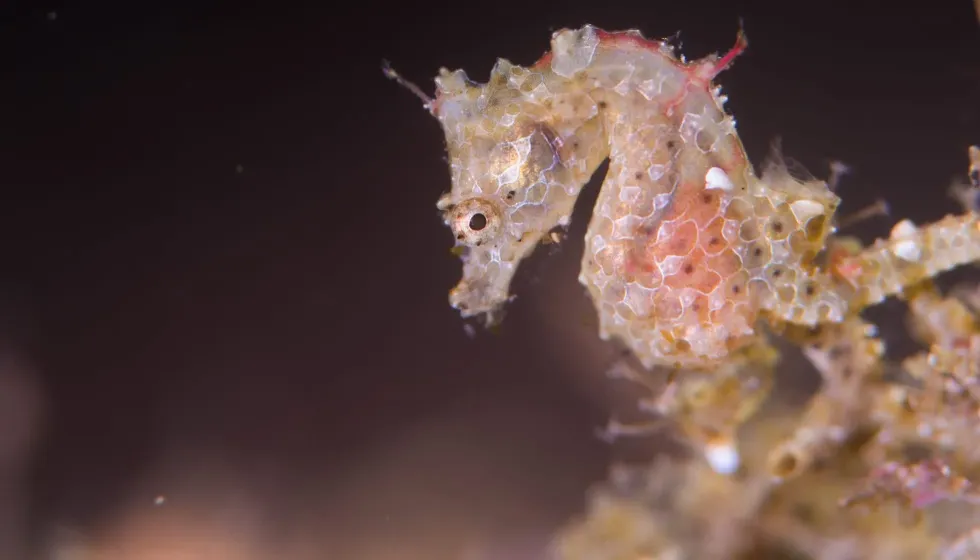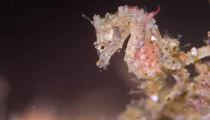There are a total of 47 different species of seahorses in the world. Several species of seahorses have similar overall appearance however, they may vary in coloration slightly.
The Japanese seahorse hippocampus description is usually as an upright seahorse of a fish but they are more than just that. They are an essential part of the marine ecosystem and help balance the distribution of marine animals through the food chain they are a part of.
The Japanese seahorse hippocampus is a dark brown seahorse that is short in length. It is easy to confuse its description with other seahorses.
If you have studied the basics of fish biology you would know how essential the shape of marine animals (streamlined shape) is in order to ensure ease in locomotion for such fish, yet seahorses lack this shape and are unlike other marine life and move extremely slowly owing to the fact that their shape and structure is distinct.
These unique marine fishes however possess their own set of unique traits and qualities.
Did you know that streamlined fish biology influenced creators to build ships and boats in similar shapes to sustain movement on water bodies by reducing friction?
Read on for more fun facts. If you like this article then visit catfish and freshwater drum articles as well.
Japanese Seahorse Interesting Facts
What type of animal is a Japanese seahorse?
The Japanese seahorse (Hippocampus mohnikei) is a type of marine animal that resides in several coral reefs alongside seaweed rafts and belongs to the kingdom Animalia.
What class of animal does a Japanese seahorse belong to?
The Japanese seahorse (Hippocampus mohnikei) is a type of fish that belongs to the class Actinopterygii, family Syngnathidae, and genus Hippocampus.
How many Japanese seahorses are there in the world?
The exact population of the Japanese seahorse (Hippocampus mohnikei) is not estimated however, there are a total of 47 different species around the world.
Where does a Japanese seahorse live?
The Japanese seahorse (Hippocampus mohnikei) is seen widely around the western Pacific Ocean range as well as other water bodies that are not extremely deep or cold and is seen mainly in Japan, China, and Vietnam.
What is a Japanese seahorse's habitat?
They are seen in habitats that range from oceans to other water bodies in seagrass beds, and offshore in seaweed rafts, bays, coasts, estuaries, and coral reefs. They don't stay within any specific range to host and cling onto algal turfs and estuaries.
They were initially seen primarily in Japanese waters but they are also seen along the estuaries and coastlines of Cambodia, India, Malaysia, Singapore, Vietnam, China, and Thailand.
Who does a Japanese seahorse live with?
Japanese seahorses are solitary beings and come together for mating. Once they form a pair, however, they stay together with their mate at all times.
How long does a Japanese seahorse live?
The Japanese seahorse (Hippocampus mohnikei) exact lifespan is not known however, seahorses are estimated to live for one to five years. Fun fact: larger seahorses live longer than shorter ones.
How do they reproduce?
Seahorses are unique animals where the male gives birth to the young. The female deposits the eggs into the male's sac/pouch which is the host.
After fertilization of the eggs for a month, the male gives birth.
To give birth, the male attaches his tail which is curved and average-sized in length to anything which he can get his tail around in a secluded region away from any predators or at least in a surrounding where he easily blends in.
The father then cares for the young to prepare them for life in the sea and is always around for the young ones.
What is their conservation status?
The Japanese seahorse (Hippocampus mohnikei) is classified as Vulnerable by the International Union For Conservation Of Nature (IUCN). Its conservation status has been affected primarily due to habitat loss.
Japanese Seahorse Fun Facts
What do Japanese seahorses look like?
The Japanese seahorse (Hippocampus mohnikei) is a short, dark-brown colored seahorse. It has a long tail, a flattened spine, and a tiny caudal fin with just two rays. It has dorsal, anal, and pectoral fins.
It has a bony ridge that runs down its back followed by a curved tail. The tail is a unique identifying feature in seahorses.
Tails are rarely seen in marine fish. The seahorse tail helps facilitate movement and the tail is flexible as well. The Japanese seahorse (Hippocampus mohnikei) is usually seen near coral reefs and other similar environments where it can easily camouflage.
Seahorses have excellent vision. Their eyes help them look forward and backward at the same time. A fun fact is that seahorses have no teeth or stomach, they digest what they eat almost instantly and then search for alternative sources of food to keep themselves full. Females lack a brood pouch which the male possesses.

How cute are they?
They are small and cute. They get camouflaged into the coral reefs easily hence even if you visit them in aquariums you need to keep a keen eye to spot them.
How do they communicate?
Seahorses have various modes of communication both through sounds as well as through body language. While mating, seahorses are known to perform an elaborate dance before courtship which could last several days until the pair finally mate.
Seahorses can sometimes growl when they are stressed. They also notify larger marine animals to be aware. This sound however is not detectable to the human ear.
How big is a Japanese seahorse?
The Japanese seahorse (Hippocampus mohnikei) is 3.14 in (8 cm) long which is around six times bigger than the smallest seahorse in the world i.e. pygmy seahorse named in 2008 and measures 0.55 in (1.4 cm). The pygmy seahorse almost blends in with its coral reef environment making it next to impossible to identify.
How fast can a Japanese seahorse move?
Japanese seahorses like other species of seahorses are known to be terrible swimmers owing to their shape and structure. They are slow swimmers and may even die of exhaustion. They move by using the two small fins on their back.
How much does a Japanese seahorse weigh?
The exact weight of the Japanese seahorse has not been documented yet however, they may appear similar in size to the lined seahorse.
What are the male and female names of the species?
The male and female are not addressed differently but as a group, they are referred to as a herd. Their biology is distinct because in these species males usually carry the offspring.
Female biology lacks a brood pouch. The male and female stay together as a pair and when a partner dies the other does not find another mate, however, they don't die together.
What would you call a baby Japanese seahorse?
A baby Japanese seahorse is extremely little in length almost invisible unless observed closely and is referred to as a fry similar to other species of fish.
What do they eat?
They are carnivores and feed usually on zooplankton and animals which are in their immature stages in the water body like crustaceans, mollusks, krill, jellyfish, and sometimes on segmented worms. They don't feed on any other matter and reside near coral reefs.
They are known as one of the best predators owing to their speed and predatory sense. Importing and exporting dried seahorses is illegal.
Are they dangerous?
Don't go by the size of these small and short beings. They are extremely good at camouflaging themselves. They have sneaky hunting skills and are one of the most skillful predators in the marine species. A stress response is common when approached and in such instances, they are known to cause abrasions or even break parts of their body.
Would they make a good pet?
Seahorses are popular aquarium animals but you won't find them at a local pet shop. Japanese seahorses for sale are also a rare event because there are legalities associated with owning such species.
Don't be disheartened however since you could visit recognized aquariums near your region and see the Japanese pygmy seahorse and other species of seahorses. There are various aquariums in Singapore, Malaysia, Japan as well as other Asian regions. There are currently five recognized species of seahorses in America.
Did you know...
The first and rarest seahorse in the world is the Knysna seahorse. They are an endangered species and easy to spot on the southern African coastline.
Although the Japanese seahorse is found largely in Japanese and Vietnam water bodies some of these species were sighted in the waters of Goa, India as well.
The seahorse's Japanese name means sea monster since they believed it to be a baby dragon. Seahorse in Japanese is used in many parts as a derogatory term as well.
The Japanese word for seahorse is 'tatsu otishigo' which means an illegitimate child of a dragon. Seahorses, however, in Japanese seahorse myths, were also considered a sign of good charm and fortune and may also be a symbol of power and strength.
A new Japanese pygmy seahorse was discovered in the eastern part of South Africa. The new pygmy seahorse was named the African or Sodwana Bay Pygmy seahorse.
The only new pygmy seahorse to be found outside the coral triangle is the Japanese pygmy seahorse. To buy a new Japanese pygmy seahorse, you need to ensure the legalities in your region permit it and also contact a legalized owner. The pygmy seahorse is not a rare species to spot.
Zookeys is a new open-access journal where you can find access to descriptions, data, and scientific information related to all fields of zoology.
Do seahorse males give birth?
Japanese seahorse (Hippocampus mohnikei) males give birth and the females just deposit the fertilized eggs into the males' brood pouch. Males carry the offspring in their stomachs for a month before depositing them. The father is always around and then cares for the young to prepare them for life in the sea.
Some species however leave the juveniles to take care of themselves. Males are also known to eat their own in some instances. Males give birth because females lack a brood pouch.
How many different types of seahorses exist?
There are a total of 47 distinct species of seahorses in the world. Most species of seahorses vary in color, size, and shape. Their name in most instances suggests their appearance as well, for example, the zebra seahorse and tiger-tailed seahorse among others.
There are certain species, however, that appear similar. In such instances, it's easy to consult a professional in the field to help you identify them. Big-belly seahorses are considered to be the most beautiful species of seahorses and Brazilian seahorses are the most colorful.
Here at Kidadl, we have carefully created lots of interesting family-friendly animal facts for everyone to discover! Learn more about some other fish from our guppy facts and tang fish interesting facts pages.
You can even occupy yourself at home by coloring in one of our free printable Japanese seahorse coloring pages.










